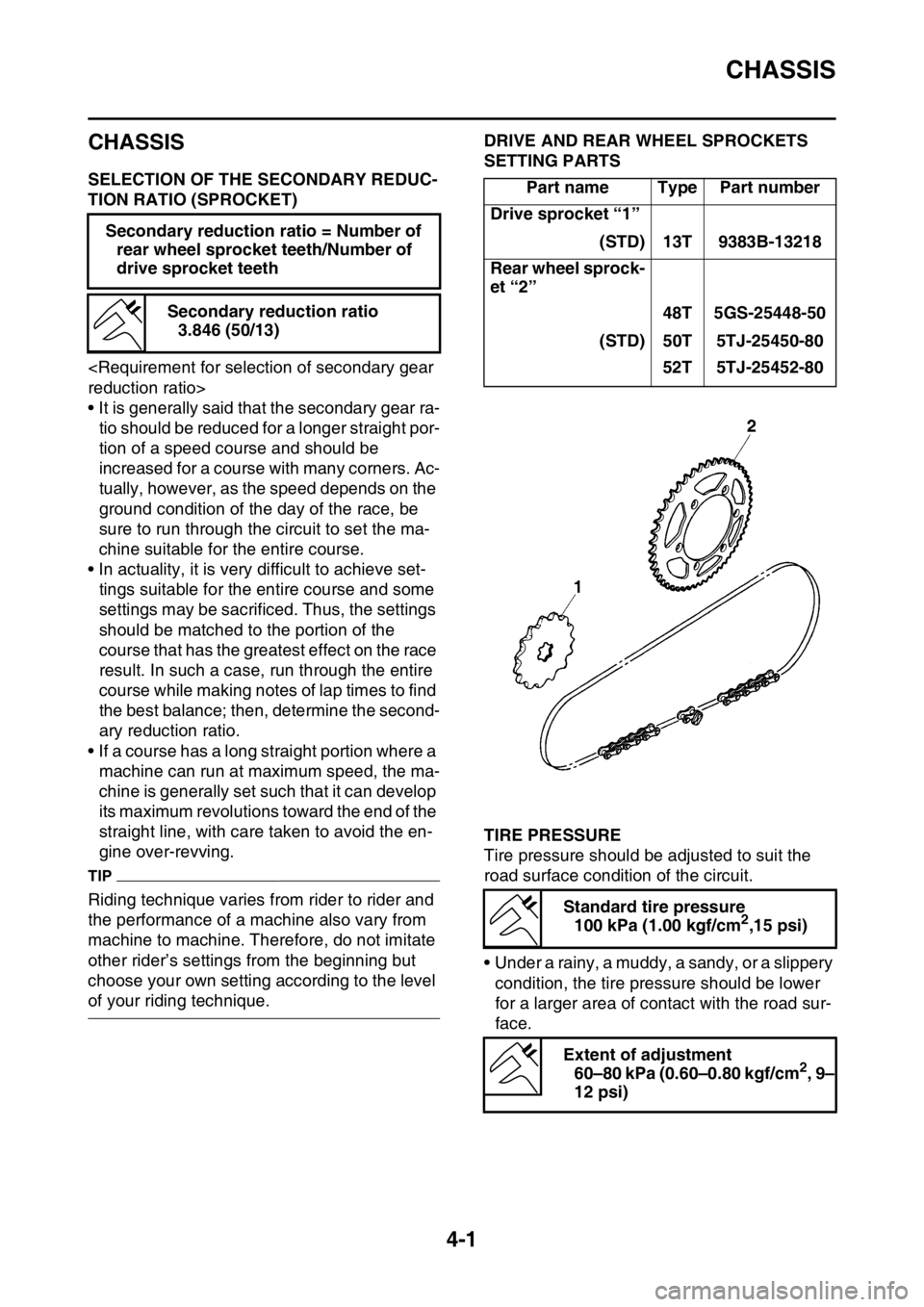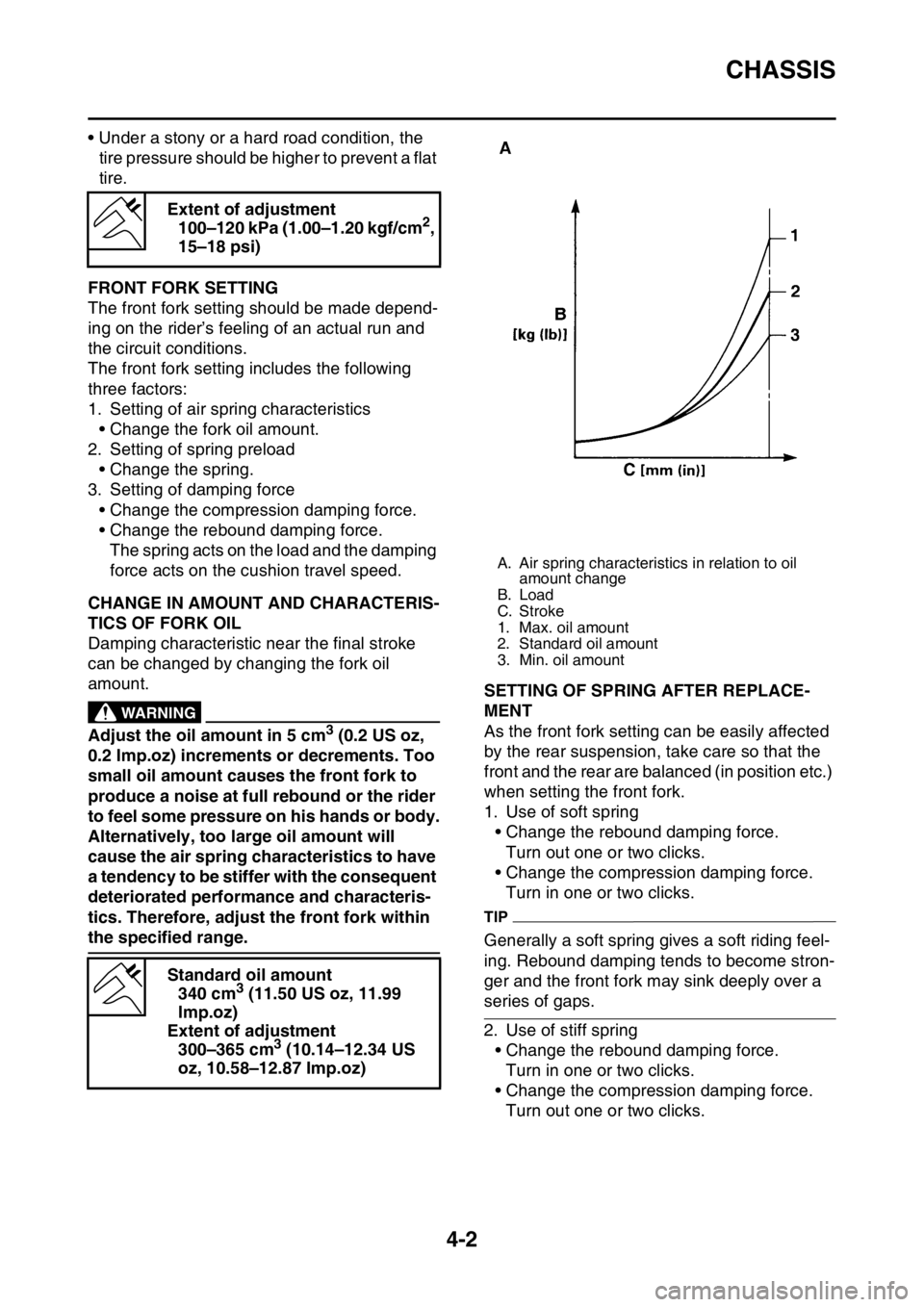tire pressure YAMAHA WR 250F 2017 Owners Manual
[x] Cancel search | Manufacturer: YAMAHA, Model Year: 2017, Model line: WR 250F, Model: YAMAHA WR 250F 2017Pages: 432, PDF Size: 14.14 MB
Page 52 of 432

MOTORCYCLE CARE AND STORAGE
1-38
e. Remove the spark plug cap from the spark
plug, and then install the spark plug and the
spark plug cap. WARNING! To prevent
damage or injury from sparking, make
sure to ground the spark plug electrodes
while turning the engine over.
▲▲▲▲▲▲▲▲▲▲▲▲▲▲▲▲▲▲▲▲▲▲▲▲▲▲▲▲▲▲▲▲
4. Lubricate all control cables and the pivoting
points of all levers and pedals as well as of
the sidestand/ centerstand.
5. Check and, if necessary, correct the tire air
pressure, and then lift the motorcycle so that
both of its wheels are off the ground. Alter-
natively, turn the wheels a little every month
in order to prevent the tires from becoming
degraded in one spot.
6. Cover the muffler outlet with a plastic bag to
prevent moisture from entering it.
7. Remove the battery and fully charge it. Store
it in a cool, dry place and charge it once a
month. Do not store the battery in an exces-
sively cold or warm place [less than 0 °C (30
°F) or more than 30 °C (90 °F)]. For more in-
formation on storing the battery, See page
9-69.
TIP
Make any necessary repairs before storing the
motorcycle.
Page 60 of 432

CHASSIS SPECIFICATIONS
2-7
EAS2GBB063
CHASSIS SPECIFICATIONS
Chassis
Frame type Semi double cradle
Caster angle 26.3 °
Trail 114 mm (4.5 in)
Front wheel
Wheel type Spoke wheel
Rim size 1.60 21
Rim material Aluminum
Wheel travel 310 mm (12.2 in)
Radial wheel runout limit 2.0 mm (0.08 in)
Lateral wheel runout limit 2.0 mm (0.08 in)
Wheel axle bending limit 0.50 mm (0.02 in)
Rear wheel
Wheel type Spoke wheel
Rim size 2.15 18
Rim material Aluminum
Wheel travel 318 mm (12.5 in)
Radial wheel runout limit 2.0 mm (0.08 in)
Lateral wheel runout limit 2.0 mm (0.08 in)
Wheel axle bending limit 0.50 mm (0.02 in)
Front tire
Type With tube
Size 80/100-21 51M (USA) (CAN)
90/90-21 M/C 54M M+S (EUR) (AUS) (NZL)
(ZAF)
Manufacturer/model DUNLOP/MX51FA (USA) (CAN)
PIRELLI/SIX DAYS EXTREME (EUR) (AUS)
(NZL) (ZAF)
Rear tire
Type With tube
Size 110/100-18 64M (USA) (CAN)
130/90-18 M/C 69M M+S (EUR) (AUS) (NZL)
(ZAF)
Manufacturer/model DUNLOP/MX51 (USA) (CAN)
PIRELLI/SIX DAYS EXTREME (EUR) (AUS)
(NZL) (ZAF)
Tire air pressure (measured on cold tires)
Front 100 kPa (1.00 kgf/cm2, 15 psi)
Rear 100 kPa (1.00 kgf/cm2, 15 psi)
Front brake
Type Hydraulic single disc brake
Operation Right hand operation
Front disc brake
Disc outside diameter thickness 270.0 3.0 mm (10.63 0.12 in)
Brake disc thickness limit 2.5 mm (0.10 in)
Brake pad lining thickness 4.4 mm (0.17 in)
Limit 1.0 mm (0.04 in)
Master cylinder inside diameter 9.52 mm (0.37 in)
Caliper cylinder inside diameter 22.65 mm, 22.65 mm (0.89 in, 0.89 in)
Specified brake fluid DOT 4
Page 102 of 432

PERIODIC MAINTENANCE
3-2
EAS2GBB077GENERAL MAINTENANCE AND LUBRICATION CHART
NO. ITEM CHECKS AND MAINTENANCE JOBSINITIALODOMETER READ-
INGS
600 mi
(1000
km) or 1
month1800 mi
(3000
km) or 3
months3000 mi
(5000
km) or 6
months
1Clutch• Check operation.
• Adjust or replace cable.
2*Cooling sys-
tem• Check hoses for cracks of damage.
• Replace if necessary.
• Replace with ethylene glycol anti-
freeze coolant every 1 year.Every 1 year
3*Spark arrest-
er• Clean.
4*Front brake• Check operation, fluid level, and for flu-
id leakage.
• Replace brake pads if necessary.
• Replace brake fluid every 1 year. Every 1 year
5*Rear brake• Check operation, fluid level, and for flu-
id leakage.
• Replace brake pads if necessary.
• Replace brake fluid every 1 year. Every 1 year
6*Brake hoses• Check for cracks or damage.
• Replace. Every 4 years
7*Wheels• Check runout, spoke tightness and for
damage.
• Tighten spokes if necessary.
8*Tires• Check tread depth and for damage.
• Replace if necessary.
• Check air pressure.
• Correct if necessary.
9*Wheel bear-
ings• Check bearings for smooth operation.
• Replace if necessary.
10*Swingarm
pivot bear-
ings• Check bearing assemblies for loose-
ness.
• Moderately repack with lithium-soap-
based grease.
11Drive chain• Check chain slack/alignment and con-
dition.
• Adjust and lubricate chain with a spe-
cial O-ring chain lubricant thoroughly.Every ride
12*Steering
bearings• Check bearing assemblies for loose-
ness.
• Moderately repack with lithium-soap-
based grease every 1200 mi (2000
km) or 12 months (whichever comes
first).
Page 109 of 432

PRE-OPERATION INSPECTION AND MAINTENANCE
3-9
EAS2GBB079
PRE-OPERATION INSPECTION AND MAINTENANCE
Before riding for break-in operation, practice or a race, make sure the machine is in good operating
condition.
Before using this machine, check the following points.
EAS2GBB080GENERAL INSPECTION AND MAINTENANCE
TIP
Perform usual maintenance enough so that, in the race course, a confirmation of that and simple set-
ting adjustments may only be left, in order to get enough time to use effectively.ITEM inspect Page
CoolantCheck that coolant is filled up to the radiator cap.
Check the cooling system for leakage.3-10 – 12
FuelCheck that a fresh gasoline is filled in the fuel tank.
Check the fuel line for leakage.1-30
Engine oilCheck that the oil level is correct. Check the crank-
case and oil line for leakage.3-16 – 18
Gear shifter and clutchCheck that gears can be shifted correctly in order and
that the clutch operates smoothly.3-12 – 13
Throttle grip/HousingCheck that the throttle grip operation and free play
are correctly adjusted. Lubricate the throttle grip and
housing, if necessary.3-13 – 14
BrakesCheck the play of front brake and effect of front and
rear brake.3-25 – 31
Drive chainCheck drive chain slack and alignment. Check that
the drive chain is lubricated properly.3-31
5-69 – 71
WheelsCheck for excessive wear and tire pressure. Check
for loose spokes and have no excessive play.3-36 – 37
SteeringCheck that the handlebar can be turned smoothly and
have no excessive play.3-37 – 38
Front forks and rear
shock absorberCheck that they operate smoothly and there is no oil
leakage.3-32 – 36
Cables (wires)Check that the clutch and throttle cables move
smoothly. Check that they are not caught when the
handlebars are turned or when the front forks travel
up and down.—
Exhaust pipeCheck that the exhaust pipe is tightly mounted and
has no cracks.3-15 – 16
Rear wheel sprocketCheck that the rear wheel sprocket tightening bolt is
not loose.5-10 – 11
LubricationCheck for smooth operation. Lubricate if necessary. 3-14
3-38 – 39
Bolts and nutsCheck the chassis and engine for loose bolts and
nuts.1-34 – 35
Lead connectorsCheck that the AC magneto, ECU and ignition coil are
connected tightly.1-9 – 12
SettingsIs the machine set suitably for the condition of the rac-
ing course and weather or by taking into account the
results of test runs before racing? Are inspection and
maintenance completely done?4-1 – 8
Page 125 of 432

CHASSIS
3-25
EAS2GBB101
CHASSIS
EAS2GBB102BLEEDING THE BRAKE SYSTEMEWA
WARNING
Bleed the brake system whenever:
• The system is disassembled.
• A brake hose is loosened, disconnected,
or replaced.
• The brake fluid level is very low.
• Brake operation is faulty.
1. Remove:
• Brake master cylinder cap
• Reservoir diaphragm
• Reservoir float (front brake)
• Protector (rear brake)
TIP
• Be careful not to spill any brake fluid or allow
the reservoir to overflow.
• Make sure that there is enough brake fluid be-
fore applying the brake. Ignoring this precau-
tion could allow air to enter the brake system,
considerably lengthening the bleeding proce-
dure.
• If bleeding is difficult, it may be necessary to
let the brake fluid settle for a few hours. Re-
peat the bleeding procedure when the tiny
bubbles in the hose have disappeared.
2. Bleed the brake system.
▼▼▼▼▼▼▼▼▼▼▼▼▼▼▼▼▼▼▼▼▼▼▼▼▼▼▼▼▼▼▼▼
a. Fill the reservoir to the proper level with the
recommended brake fluid.
b. Install the reservoir diaphragm.
c. Connect the plastic hose “1” to the bleed
screw “2” securely, and place a container
under the end of the plastic hose.d. Slowly apply the brake several times.
e. Fully pull the brake lever or fully press down
the brake pedal and hold it in position.
f. Loosen the bleed screw.
TIP
Loosening the bleed screw will release the
pressure in the brake caliper and cause the
brake lever to contact the throttle grip or the
brake pedal to fully extend.
g. Tighten the bleed screw and then release
the brake lever or brake pedal.
h. Repeat steps (d) to (g) until all of the air bub-
bles have disappeared from the brake fluid
in the plastic hose.
TIP
During the procedure, keep adding brake fluid
to the reservoir.
ECA
NOTICE
• Wipe off any brake fluid on the brake
discs, tires, wheels, etc.
• Brake fluid may erode painted surfaces or
plastic parts. Always clean up spilled fluid
immediately.
i. Tighten the bleed screw.
j. Pour brake fluid to the reservoir up to the
specified level.
Refer to “CHECKING THE BRAKE FLUID
LEVEL” on page 3-30.
EWA
WARNING
After bleeding the hydraulic brake system,
check the brake operation.
▲▲▲▲▲▲▲▲▲▲▲▲▲▲▲▲▲▲▲▲▲▲▲▲▲▲▲▲▲▲▲▲
1 2
A
A. Front
B. Rear
Bleed screw
6 Nm (0.6 m·kgf, 4.3 ft·lbf)
2
1B
T R..
Page 136 of 432

CHASSIS
3-36
Compression damping (for slow compres-
sion damping)
ECA
NOTICE
Do not turn the adjuster forcibly beyond its
adjusting range.
1. Adjust:
• Compression damping (for slow compres-
sion damping)
▼▼▼▼▼▼▼▼▼▼▼▼▼▼▼▼▼▼▼▼▼▼▼▼▼▼▼▼▼▼▼▼
a. Turn the adjuster “1” in the direction of “a” or
“b” to make an adjustment.
▲▲▲▲▲▲▲▲▲▲▲▲▲▲▲▲▲▲▲▲▲▲▲▲▲▲▲▲▲▲▲▲
EAS2GBB119CHECKING THE TIRES
1. Measure:
• Tire pressure
Out of specification Regulate.
TIP
• Check the tire while it is cold.
• Loose bead stoppers allow the tire to slip off
its position on the rim when the tire pressure
is low.
• If the tire valve stem is found tilted, the tire is
considered to be slipping off its position. Cor-
rect the tire position.
EAS2GBB120CHECKING AND TIGHTENING THE
SPOKES
1. Check:
• Spokes
Bend/damage Replace.
Loose Tighten.
TIP
A tight spoke will emit a clear, ringing tone; a
loose spoke will sound flat.
2. Tighten:
• Spokes
Use a spoke nipple wrench “1” for tighten-
ing. Direction “a”
Compression damping is increased
(suspension is harder).
Direction “b”
Compression damping is decreased
(suspension is softer).
Compression damping setting
(for slow compression damping)
Maximum
Fully turned in
Standard
10 clicks out*
Minimum
20 clicks out*
* With the adjuster fully turned in
Tire air pressure (measured on cold
tires)
Front
100 kPa (1.00 kgf/cm
2, 15 psi)
Rear
100 kPa (1.00 kgf/cm
2, 15 psi)
1ba
Page 143 of 432

4
TUNING
CHASSIS.......................................................................................................... 4-1
SELECTION OF THE SECONDARY REDUCTION RATIO
(SPROCKET) ............................................................................................ 4-1
DRIVE AND REAR WHEEL SPROCKETS SETTING PARTS .................. 4-1
TIRE PRESSURE....................................................................................... 4-1
FRONT FORK SETTING............................................................................ 4-2
CHANGE IN AMOUNT AND CHARACTERISTICS OF FORK OIL............ 4-2
SETTING OF SPRING AFTER REPLACEMENT ...................................... 4-2
FRONT FORK SETTING PARTS............................................................... 4-3
REAR SUSPENSION SETTING ................................................................ 4-3
CHOOSING SET LENGTH ........................................................................ 4-3
SETTING OF SPRING AFTER REPLACEMENT ...................................... 4-4
REAR SHOCK ABSORBER SETTING PARTS ......................................... 4-4
SUSPENSION SETTING (FRONT FORK)................................................. 4-6
SUSPENSION SETTING (REAR SHOCK ABSORBER) ........................... 4-7
Page 144 of 432

CHASSIS
4-1
EAS2GBB136
CHASSIS
EAS2GBB137SELECTION OF THE SECONDARY REDUC-
TION RATIO (SPROCKET)
• It is generally said that the secondary gear ra-
tio should be reduced for a longer straight por-
tion of a speed course and should be
increased for a course with many corners. Ac-
tually, however, as the speed depends on the
ground condition of the day of the race, be
sure to run through the circuit to set the ma-
chine suitable for the entire course.
• In actuality, it is very difficult to achieve set-
tings suitable for the entire course and some
settings may be sacrificed. Thus, the settings
should be matched to the portion of the
course that has the greatest effect on the race
result. In such a case, run through the entire
course while making notes of lap times to find
the best balance; then, determine the second-
ary reduction ratio.
• If a course has a long straight portion where a
machine can run at maximum speed, the ma-
chine is generally set such that it can develop
its maximum revolutions toward the end of the
straight line, with care taken to avoid the en-
gine over-revving.
TIP
Riding technique varies from rider to rider and
the performance of a machine also vary from
machine to machine. Therefore, do not imitate
other rider’s settings from the beginning but
choose your own setting according to the level
of your riding technique.
EAS2GBB138DRIVE AND REAR WHEEL SPROCKETS
SETTING PARTS
EAS2GBB139TIRE PRESSURE
Tire pressure should be adjusted to suit the
road surface condition of the circuit.
• Under a rainy, a muddy, a sandy, or a slippery
condition, the tire pressure should be lower
for a larger area of contact with the road sur-
face. Secondary reduction ratio = Number of
rear wheel sprocket teeth/Number of
drive sprocket teeth
Secondary reduction ratio
3.846 (50/13)
Part name Type Part number
Drive sprocket “1”
(STD) 13T 9383B-13218
Rear wheel sprock-
et “2”
48T 5GS-25448-50
(STD) 50T 5TJ-25450-80
52T 5TJ-25452-80
Standard tire pressure
100 kPa (1.00 kgf/cm
2,15 psi)
Extent of adjustment
60–80 kPa (0.60–0.80 kgf/cm
2, 9–
12 psi)
Page 145 of 432

CHASSIS
4-2
• Under a stony or a hard road condition, the
tire pressure should be higher to prevent a flat
tire.
EAS2GBB140FRONT FORK SETTING
The front fork setting should be made depend-
ing on the rider’s feeling of an actual run and
the circuit conditions.
The front fork setting includes the following
three factors:
1. Setting of air spring characteristics
• Change the fork oil amount.
2. Setting of spring preload
• Change the spring.
3. Setting of damping force
• Change the compression damping force.
• Change the rebound damping force.
The spring acts on the load and the damping
force acts on the cushion travel speed.
EAS2GBB141CHANGE IN AMOUNT AND CHARACTERIS-
TICS OF FORK OIL
Damping characteristic near the final stroke
can be changed by changing the fork oil
amount.
EWA
WARNING
Adjust the oil amount in 5 cm3 (0.2 US oz,
0.2 Imp.oz) increments or decrements. Too
small oil amount causes the front fork to
produce a noise at full rebound or the rider
to feel some pressure on his hands or body.
Alternatively, too large oil amount will
cause the air spring characteristics to have
a tendency to be stiffer with the consequent
deteriorated performance and characteris-
tics. Therefore, adjust the front fork within
the specified range.
EAS2GBB142SETTING OF SPRING AFTER REPLACE-
MENT
As the front fork setting can be easily affected
by the rear suspension, take care so that the
front and the rear are balanced (in position etc.)
when setting the front fork.
1. Use of soft spring
• Change the rebound damping force.
Turn out one or two clicks.
• Change the compression damping force.
Turn in one or two clicks.
TIP
Generally a soft spring gives a soft riding feel-
ing. Rebound damping tends to become stron-
ger and the front fork may sink deeply over a
series of gaps.
2. Use of stiff spring
• Change the rebound damping force.
Turn in one or two clicks.
• Change the compression damping force.
Turn out one or two clicks. Extent of adjustment
100–120 kPa (1.00–1.20 kgf/cm
2,
15–18 psi)
Standard oil amount
340 cm
3 (11.50 US oz, 11.99
lmp.oz)
Extent of adjustment
300–365 cm
3 (10.14–12.34 US
oz, 10.58–12.87 Imp.oz)
A. Air spring characteristics in relation to oil
amount change
B. Load
C. Stroke
1. Max. oil amount
2. Standard oil amount
3. Min. oil amount
Page 422 of 432

TROUBLESHOOTING
10-3
Cooling system
1. Coolant
• Low coolant level
2. Radiator
• Damaged or leaking radiator
• Faulty radiator cap
• Bent or damaged radiator fin
3. Water pump
• Damaged or faulty water pump
• Damaged hose
• Improperly connected hose
• Damaged pipe
• Improperly connected pipe
Fuel system
1. Throttle body
• Damaged or loose throttle body joint
2. Air filter
• Clogged air filter element
Chassis
1. Brake(s)
• Dragging brake
Electrical system
1. Spark plug
• Incorrect spark plug gap
• Incorrect spark plug heat range
2. Ignition system
• Faulty ECU
• Faulty coolant temperature sensor
EAS2GBB416OVERCOOLING
Cooling system
1. Coolant temperature sensor
• Faulty coolant temperature sensor
EAS2GBB417POOR BRAKING PERFORMANCE
Chassis
1. Brake(s)
• Worn brake pad
• Worn brake disc
• Air in hydraulic brake system
• Leaking brake fluid
• Defective master cylinder kit
• Faulty brake caliper kit
• Faulty brake caliper seal
• Loose union bolt
• Damaged brake hose
• Oil or grease on the brake disc
• Oil or grease on the brake pad
• Incorrect brake fluid level
EAS2GBB418FRONT FORK OIL LEAKING
Chassis
1. Front fork
• Bent, damaged, or rusty inner tube
• Cracked or damaged outer tube
• Improperly installed oil seal
• Damaged oil seal lip
• Incorrect oil level (high)
• Loose damper rod assembly bolt
• Damaged damper rod assembly bolt copper
washer
• Cracked or damaged cap bolt O-ring
EAS2GBB419FAULTY FRONT FORK LEGS
Chassis
1. Front fork
• Bent or damaged inner tube
• Bent or damaged outer tube
• Broken fork spring
• Bent or damaged damper rod
• Incorrect oil viscosity
• Incorrect oil level
EAS2GBB420UNSTABLE HANDLING
Chassis
1. Handlebar
• Bent or improperly installed handlebar
2. Steering head components
• Improperly installed upper bracket
• Improperly installed lower bracket
(improperly tightened ring nut)
• Bent steering stem
• Damaged ball bearing or bearing race
3. Front fork leg (s)
• Uneven oil levels (both front fork legs)
• Unevenly tensioned fork spring (both front
fork legs)
• Broken fork spring
• Bent or damaged inner tube
• Bent or damaged outer tube
4. Swingarm
• Worn bearing or bushing
• Bent or damaged swingarm
5. Rear shock absorber assembly (-ies)
• Faulty rear shock absorber spring
• Leaking oil or gas
6. Tire (s)
• Uneven tire pressures (front and rear)
• Incorrect tire pressure
• Uneven tire wear